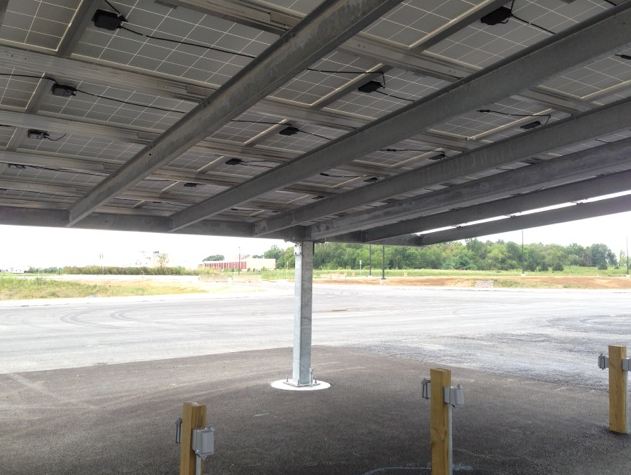The PV Racking clamp-free rail was a great solution for this carport, as it helped to eliminate rain water leaking through the arrays in comparison to a traditional clamp-based system.
Case Study - 28kW Custom Carport in Frederick, MD
Contributed by | PV Racking
In August of 2014, PV Racking teamed with Design Depictions Structural Engineering, P.C. and SolarVisuals to design, manufacture, and install two 14 kilowatt custom solar carports. The carport structures, located on the Fort Detrick military base in Frederick, Maryland, were each custom designed to charge eight electric military vehicles. Both carports structures were installed by a four-man crew in only two and a half days. All custom steel and racking components were manufactured by PV Racking.
Carport Design
The system owner had a very specific vision for their carport design. The project came to PV Racking in the very early stages, when the system owner’s vision was presented as a 3D rendering. PV Racking was able to transform the customer’s vision into a workable design. PV Racking has the ability to custom design solar structures based on the special needs of each customer. In their own 30,000 sq. ft. warehouse and machine shop, PV Racking manufactured the custom carport to meet the needs of the Fort Detrick military base. Each carport was designed to withstand 115mph wind loads, and 30 psf snow loads.
Other racking companies typically don’t have the ability to provide custom designed work. It’s rare that a “one size fits all” mentality will work. PV Racking makes sure that the customer gets a competitively priced racking system that meets their needs.
PV Racking Slide-In Rail
PV Racking utilizes a unique clamp-free system that is much quicker and easier to install than traditional clamp-based systems on the market today. The slide-in rail is available for ground, pitched roof and carport projects. Installation time with PV Racking is reduced by about 30%, therefore cutting on-site labor costs. In addition to a seamless appearance, the PV Racking slide-in rail offers full panel frame coverage which provides a more secure panel installation.
This project consisted of two arrays, each at a 5 degree tilt with a 8x7 layout with the panels in landscape orientation. The PV Racking clamp-free rail was a great solution for this carport, as it helped to eliminate rain water leaking through the arrays in comparison to a traditional clamp-based system. The panels sit next to one another with no gaps between panels.
Conclusion
PV Racking offers their clamp-free solution on ground, pitched roof and carport projects. The slide-in rail solution has several key advantages over clamp-based systems on the market today. By sliding the panels into place, the installation time is significantly reduced. This system also allows for a more stable and secure solar array.
The content & opinions in this article are the author’s and do not necessarily represent the views of AltEnergyMag
Comments (0)
This post does not have any comments. Be the first to leave a comment below.
Featured Product


.JPG)
